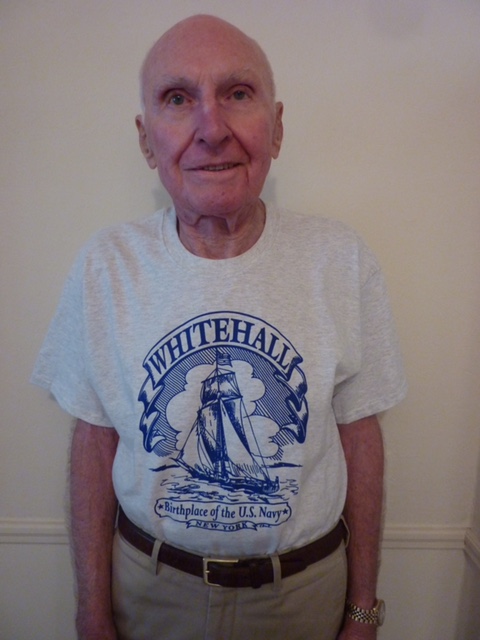
Richard D. “Moon” Mullen, Commander United States Navy and former Prisoner of War in Vietnam, proudly wears his Whitehall shirt given to him by Peter Ballantyne. Captain Mullen is the recipient of the the Silver Star, Legion of Merit, 3 Bronze Stars, Air Medal, 2 Purple Hearts, POW Medal and other decorations.
On a cold winter day, this story will warm your heart.
As I previously reported, Peter Ballantyne when in Whitehall this past summer, picked up some tee-shirts commemorating Whitehall’s contribution to the birth of the U.S. Navy. He distributed these to some veterans he works with at the Paralyzed Veterans of America, at his winter home in San Diego, California.
Last week Peter had the privilege of meeting the daughter of Captain “Moon” Mullen, whose story of bravery as a POW for over 7 years in Vietnam is well chronicled and presented below. Captain Mullen is the recipient of the Silver Star, Legion of Merit, 3 Bronze Stars, Air Medal, 2 Purple Hearts, POW Medal and other decorations. Peter Ballantyne gave Captain Mullen’s daughter one of the Whitehall shirts for her father, who proudly accepted the gift. Cdm. Mullen’s daughter passed along the above picture of her father wearing the shirt. In another coincidence of local significance, Captain Mullen’s last flight before he was shot down originated from the USS TICONDEROGA.
Cdm. Mullen was shot down on January 6, 1967 and was not released until March 4, 1974. Below is a partial account of Captain Mullen’s ordeal as presented in WE CAME HOME copyright 1977 Captain and Mrs. Frederic A Wyatt (USNR Ret), Barbara Powers Wyatt, Editor P.O.W. Publications, 10250 Moorpark St., Toluca Lake, CA 91602 Text is reproduced as found in the original publication.
Lt. Cdr. Richard D. Mullen was the pilot of a single seat fighter, a F8E Crusader assigned to Fighter Squadron 191 onboard the aircraft carrier, USS TICONDEROGA (CVA 14). Mullen launched on January 6, 1967 on his 31st combat mission over North Vietnam. During the mission, Mullen’s aircraft was seen to be engulfed in flames and explode. A good parachute was sighted and subsequently, Mullen was observed standing on the ground and waving. Contact between him and the airborne aircraft was established and Mullen reported to be “OK”. At this time, Mullen was near the coast of Nghe An Province, about five miles south of the city of Tho Son.
On subsequent passes, neither Mullen nor the parachute were sighted. However, intermittent emergency radio transmissions were heard. It was believed that Mullen was captured, and he was classified as a prisoner of war. Richard Mullen had been captured and was held prisoner by the North Vietnamese in the Hanoi Hilton (New Guy Village, Heartbreak), Zoo (Office, Pig Sty, Carraige House, Pool Hall), Camp Hope, Hanoi Hilton (Rm 3, 5) back to Heartbreak) Skid Row, Hanoi Hilton (Rm 2,3) until March 4, 1973. At that time, he was released with 590 other Americans from POW camps. He had been a prisoner for just over seven years.
He sustained no injuries upon ejection, but while captive was subjected to “the normal bone crusher manacles, ropes, leg stocks and whipping with a fan belt. The worst was strangling noose around neck tied to manacles behind my back.” While in captivity, he suffered a severe blow to his head. Since the war ended, nearly 10,000 reports relating to Americans missing, prisoner or unaccounted for in Southeast Asia have been received by the U.S. Government. Many authorities who have examined this largely classified information are convinced that hundreds of Americans are still held captive today.
Of the Crusader pilots shot down, nearly 50 are still missing. These fighter pilots in Vietnam were called upon to fly in many dangerous circumstances, and were prepared to be wounded, killed, or captured.
Richard Mullen retired in 1978 from the United States Navy as a Captain. Although retired, he remains active with youth, church, golf and travel. He still says about returning to the United States after his ordeal, “I was so choked up seeing the American flag at Clark AFB (March 4, 1973) I could barely get off the plane. Seeing my wife and children (at NAS Miramar) had to be the happiest moment of my life.”
